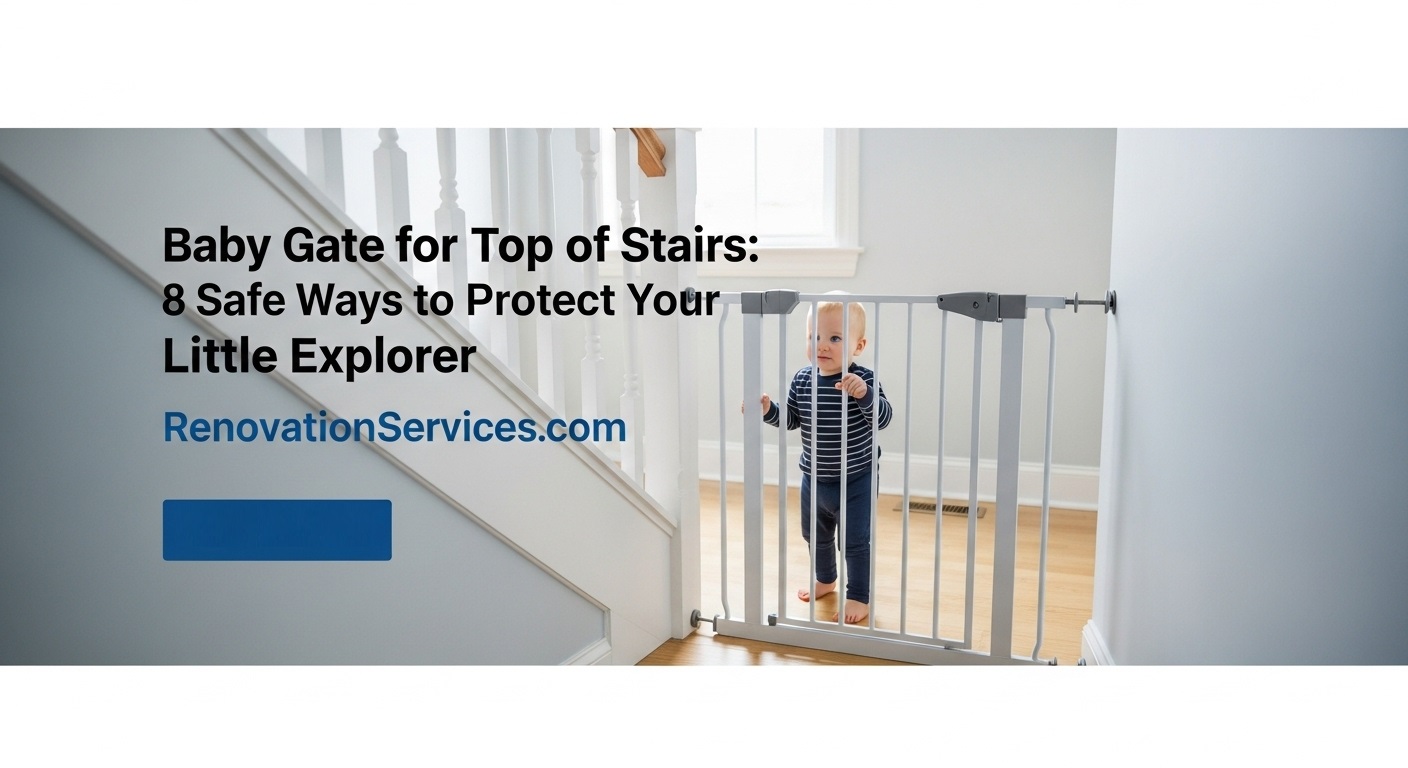Baby Gate for Top of Stairs: 8 Safe Ways to Protect Your Little Explorer
Your crawler just discovered gravity—uh-oh! Securing a baby gate for top of stairs is priority No. 1, but quirky banisters, angled rails, and wall moldings can make installation tricky. This step-by-step guide unpacks eight proven solutions, cost tables, and landlord-friendly tricks so you can sleep at night (and maybe even drink a hot coffee).
Inside you’ll find:
- Fast facts—injury stats and height rules for a baby gate for top of stairs
- Eight mounting options when pressure gates and wall studs refuse to cooperate
- “Which gate fits?” comparison table with costs, tools, and renter score
- Graph: Falls vs. Baby Age (data from the CDC)
- Five bonus safety tips every parent can knock out in one afternoon
- Case study and a printable install checklist
Planning bigger renovations? Check these cost guides while the kid naps: Kitchen Remodel, Bathroom Remodel, or Basement Finishing.
1. Why the Top-of-Stairs Zone Is Risk No. 1
The Centers for Disease Control and Prevention tracks home injuries: falls account for 3 million ER visits annually among U.S. children under 5.1 In two-story homes, 61 % of serious head injuries happen on the top three stair treads—right where tiny feet first meet the descent.
| Age (months) | % of Stair Falls |
|---|---|
| 6–9 | 11 % |
| 10–12 | 38 % |
| 13–18 | 29 % |
| 19–24 | 14 % |
| 25+ | 8 % |
Takeaway: Crawlers and early walkers need a sturdy barrier before their tenth month. Let’s see how to anchor one even when your banister situation looks impossible.
2. Anatomy of a Safe Baby Gate
- Type: Hardware-mounted only at the top of stairs—pressure gates can pop loose if a toddler rams them.
- Height: Minimum 29 inches; 31–36 inches preferred for future climbers.
- Slat spacing: Less than 2¾ inches so heads don’t wedge.
- Latch: One-hand, auto-close, impossible-for-toddler.
- Opening direction: Swing away from stairs, never over them.
Here’s the catch: many NYC and Long Island properties have banister spindles or half-walls that leave no flat posts to screw into. Below are eight creative ways to mount a baby gate for top of stairs without carving your railing to bits.
3. Eight Mounting Solutions When the Walls Don’t Line Up
| # | Solution | Cost Range | DIY Difficulty | Renter-Safe? | Main Tools |
|---|---|---|---|---|---|
| 1 | Banister-to-Banister Clamp Kit | $28–$45 | ⭐ | Yes | Allen key |
| 2 | Banister-to-Wall Adapter & Spindle Clamp | $30–$55 | ⭐⭐ | Yes | Drill (banister side only) |
| 3 | Universal Y-Spindle Hardware Gate | $55–$90 | ⭐⭐ | No* | Wrench |
| 4 | Sleeve-Over Newel Post Bracket | $40–$70 | ⭐⭐⭐ | Yes | Level, drill |
| 5 | Extra-Tall Stairway Gate with Offset Hinge | $85–$120 | ⭐⭐⭐ | No* | Impact driver |
| 6 | Half-Wall Anchor Board + Screw Gate | $12–$25 | ⭐⭐ | Depends | Stud finder, screws |
| 7 | Custom PVC “L-Frame” Clamp | $18–$30 | ⭐⭐⭐ | Yes | Pipe cutter, zip ties |
| 8 | Retractable Fabric Gate with Spacers | $95–$130 | ⭐⭐ | No* | Drill |
*“No” means screw holes will remain after move-out; ask landlord first.
Need basement stair safety too? Peek at our mold removal guide for subfloor moisture insights.
3.1 Banister-to-Banister Clamp Kit (Fastest, No Holes)
Think “picture-frame” that hugs two opposing banisters. Foam-padded blocks clamp around each post, then a hardwood crossbar anchors gate screws.
- Measure banister diameters (fits 2–3½ inches).
- Assemble four clamp blocks around each post; tighten with supplied bolts.
- Screw gate mounting cups into crossbar, not the banister.
- Level, latch, and test—pull 50 lbs outward to mimic toddler slam.
Time: 15 minutes. Cost: ~$40 plus gate.
3.2 Banister-to-Wall Adapter & Spindle Clamp
When only one side has a post, clamp one bracket, screw the other into a wall stud. Use a gate with Y-spindle bolts so the clamp side needs no holes.
4. “Which Gate Fits?” Decision Table
| Scenario | Best Solution | Why |
|---|---|---|
| Two round newels, no wall | Banister-to-banister kit | No drilling, quick removal |
| One post + drywall stud | Banister-wall adapter | Half clamp, half screw |
| Square post, parent 6′ 2″ | Extra-tall offset-hinge gate | Plenty of headroom |
| Narrow tread depth <3 ft | Retractable fabric gate | Rolls clear, no door swing |
| Rental, banister flush to wall | PVC L-frame clamp | Zero holes, $25 DIY |
Upgrading kitchen floor thresholds too? Read our vinyl threshold repair guide.
5. Graph: Child Stair-Fall Injuries vs. Age
| Age (months) | ER Visits per 10 000 |
|---|---|
| 6 | 3 |
| 9 | 7 |
| 12 | 11 |
| 15 | 9 |
| 18 | 6 |
The bell curve peaks at the one-year mark, just when babies shift from crawling to unsteady walking. Secure your baby gate for top of stairs before that explosive phase.
6. Step-by-Step: PVC “L-Frame” Clamp (Under $30 DIY)
- Cut two PVC pipes equal to banister height minus ½ inch.
- Glue a 90° elbow on each; dry-fit to form an inverted “L.”
- Zip-tie vertical leg to banister; horizontal leg becomes your screw board.
- Mount gate cups into PVC with self-drilling screws.
- Load test with 50 lbs outward force.
Paint the PVC to match trim—landlord likely won’t notice (and you can clip ties to remove later).
7. Five Bonus Safety Steps for the Stair Zone
- Anti-slip stair treads: Clear grip strips cost $18 for a 14-step kit.
- Night-light: Stick-on LED with dusk sensor keeps midnight walks safe.
- Handrail height: Code says 34–38 in; toddlers need a second “kid rail” at 22 in.
- Door stop: Rubber wedge prevents sibling slamming gate into wall.
- Teach knee-crawl: Practice safe “backward slide” descents once child turns 12 months.
8. Case Study – Queens Duplex
Problem: Stair opening 34 in wide, round banisters, no parallel walls.
Solution: Banister-to-banister clamp + 34 in hardware-mounted gate.
Tools: Allen key (included).
Time: 18 min install.
Total Cost: $38 clamp kit + $79 gate = $117.
Outcome: 22-month-old could rattle but not dislodge gate; no stair falls in 14 months.
9. FAQ
Can retractable fabric gates work at the top of stairs?
Yes, if they are ASTM-certified for stairs and mounted with screws into solid wood, not drywall.
Is drilling into a banister safe?
If the post is 1½ in thick or larger, pilot-drill and use 2-in screws. Fill holes with wood filler if you remove later.
How high above the first step should the gate sit?
Less than 3 in gap under the gate per ASTM F1004 standard.
Do I need gates at both top and bottom?
Pediatricians suggest both for under-2-year-olds; bottom gate can be pressure-mounted if stairs end on a flat floor.
What about pets?
Choose a gate with a small-pet door or a bar spacing under 2 in so cats don’t squeeze through.
Ready for a Pro Installation?
Schedule a safety walkthrough: info@renovationservices.com or 347-455-1741.
More safety & renovation guides: Roof Replacement Costs • Apartment Renovations • Stop Shower Splash.






